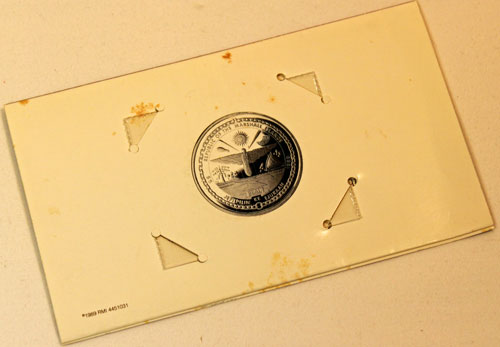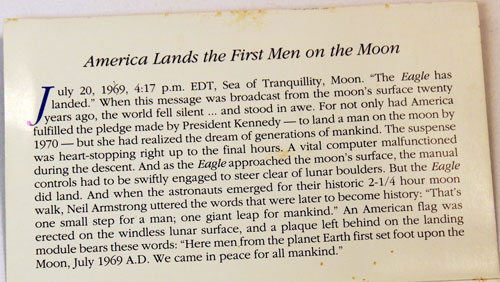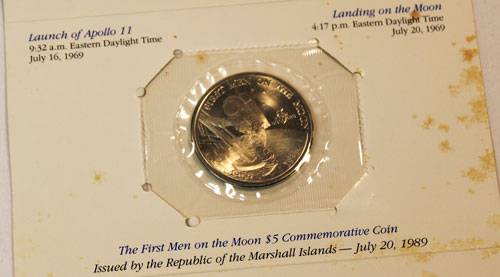On May 16, NASA launched the last mission for the shuttle program with the Endeavor shuttle and its crew. In honor of this last mission and in remembrance of the early days of NASA’s space efforts, let’s take a look at a First Men on the Moon commemorative coin.
You’re saying, “What? The US Mint did not release a First Men on the Moon coin.”
That’s true, but back in 1989, the Republic of the Marshall Islands did release a commemorative $5 coin on the 20th anniversary of Neil Armstrong and Buzz Aldrin’s first steps on the moon.
The cupronickel $5 commemorative coin was packaged in a tri-fold coin holder that provided information about the US space program, the astronauts and the obverse and reverse of the First Men on the Moon commemorative $5 coin.
The colorful front of the coin holder shows images of the men on the moon and the moon lander.
The back of the coin holder shows a picture of the reverse of the coin.
The coin holder unfolds to show the information and the First Men on the Moon $5 commemorative coin.
At the top, information about the US space program includes reference to President Kennedy’s declaration that the US would put men on the moon along with the historic, “The Eagle has landed,” comment by the Apollo 11 crew when that declaration came true.
The $5 commemorative coin in its pliofilm protective covering is held in the middle of the tri-folded coin holder. Around the coin, the dates of the Apollo 11 launch, the landing on the moon and the release of the First Men on the Moon coin are shown.
Below the coin, the text provides a decription of the coin- both obverse and reverse. The obverse design utilized a picture taken by Neil Armstrong of Buzz Aldrin as he climbed down the ladder to the moon’s surface. The reverse design shows details found on the official seal of the Republic of the Marshall Islands.
Another section of the tri-folded coin holder provides a picture of the three Apollo 11 astronauts and gives a brief biography of each.
Let’s take a closer look at the coin – the obverse:
And, the reverse:
The coin with its image of an astronaut stepping onto the moon’s surface for the first time provides a history lesson and a remembrance of the achievements of the 1960s.
With today’s technology, this First Men on the Moon commemorative $5 coin is also a reminder that the first impressive achievements into space back in the 1960s were made in spacecraft with less technogical power than can be found in a $10 calculator purchased today.
What amazing feats we can accomplish if we apply ourselves. And, this commemorative coin helps us remember the accomplishments and the people who made them.









Hello I actually have the exact commemorative coin not interested in selling just curious on the value …I would appreiciate ur help …thanks
Unfortunately, this answer is going to be indecisive.
First, the coin’s composition is cupro-nickel in an uncirculated rather than a shiny proof condition. Though uncirculated versus proof is not necessarily a value consideration since some coins are more valuable in their uncirculated form.
Second, without any precious metal content, the coin’s value depends solely on people interested in its subject matter and its collectibility.
Some numismatists and coin dealers, who are not interested in this type of collectible, will claim the value is in the range of $0 to $2.00. Others who appreciate a variety of numismatics apply a larger value. For example, one retail value shows $20.00, whereas various eBay sites list the coin in the $5 to $15 range.
But remember, a dealer will buy for less than the value at which he can sell the coin. Therefore, the above retail prices are not indicative of what a dealer will pay.
When you do want to sell (if ever), make sure you look for individuals or dealers who are interested in a variety of collectibles. It would be even better to find people who are particularly interested in space related collectibles.
Also, if/when you want to sell, take another look at the market. This coin’s value can easily change either up or down.
I have a coi, “MANS FIRST LANDING ON THE MOOD” with a picture of the space craft on the front and on the back it has :”The apollo 2 mission” . i dont see this here, is it with anything?
It really depends…don’t you just hate it when someone says that? But, in this case, several factors play a role in the value of the coin or medal.
First, the US Mint did not make a legal tender US coin for the Apollo missions, however they did make medals. Other private mints made medals as well.
For definition, we use “coin” for legal tender money and “medal” for everything else.
Other countries also made medals recognizing the Apollo 11 mission’s success. And, as we showed here, some countries also minted or commissioned the minting of coins with Apollo 11 symbols.
Your coin or medal can have intrinsic worth if it is made primarily of silver, gold or platinum. But, if it is another metal, such as copper-nickel or bronze, the medal can have value to collectors of space memorabilia.
Please provide more details about your collectible. You could have a nice keepsake or a small treasure.
Sir, have a large coin .. copper colour (kind of) .. three faces of Edwin Aldrin,Neil Armstrong, Michael Collins .. back of coin states: 1969 First U.S.A. landing on the Moon ~ space craft at a distance with an astronaut holding a long flag pole with a flag flying. As I am not sure what kind of metal it’s made of .. would a gentle rub with natural soap and gentle rubbing be a good method? I gather from the above information that was given (comments) mine would be of ‘another metal, such as copper-nickel or bronze’, not worth much the Euro 5.- I’ve paid for ~ right? Thought, I’ll give it to my young grandson of nine yrs old to remember that special day! Do give any information regarding this coin so he can appreciate it more. Found coin in a market in Den Haag/Netherlands several days ago. Thank you. (27 May’12)
Hello,
First, from a numismatist perspective, we advise never cleaning a coin, or in this case a medal, until you know for sure that it’s not valuable.
But, to make your task more difficult in finding out if your medal is valuable, many different mints, not only in the US but around the world, made medals of that historic day. Among the variety, there are gold, silver, bronze and copper-nickel versions.
Here’s a web site that shows many different Apollo 11 medals from the various mints. Their site may not be all inclusive, but you may find a picture and details about your specific medal variety.
http://www.spacecollection.info/us_apollo/apollo_medals.html
Good luck!
I jave exactly what u have shown and has not been openedor even really touched until rec
but the 1 I hav has not been opened or reall has not been opened or really touched in 20 year I was cleaning out my o and foun and found this but mine is silver not gold lookinglike urs. Does I have never been color blind in my lif I have never been color blind in my life though th thank you and please respond
Hello,
I’m not sure what question you are asking.
The coin in our pictures is neither silver nor gold. It’s made with cupro-nickel which is a mixture of copper and nickel.
The cupro-nickel metal can change colors and look either silver colored or golden colored.
If you still have the papers with your coin, look to see if it says “cupro-nickel.”
Is this coin legal tinder in the US or Marshall Islands? I have a few and thought about collecting the series. Though my research I have found conflicting statements calling it a “coin” which would make it legal tinder of the county that minted it and since the US Mint does Marshal Islands currency then I should be able to cash it in at a bank for $5 right? (I live in the USA) Actually, I am assuming the US Mint does there currency as the USD is the official currency of the Marshall Islands. So I guess the better question is was this coin, round, metal or whatever made by a private mint, official government Mint of the Marshall Islands or the US Mint Also, seen it called a “round” and “metal” which leaves it value purely numismatic as they is no metal value to it. Thanks for your response in advance.
/Mark
Hello,
Some Marshall Island “rounds” are coins and some are medals. This particular one happens to be a commemorative coin issued by the Republic of the Marshall Islands and is legal tender in the Republic of the Marshall Islands.
As you noted, the Republic of the Marshall Islands uses the US dollar as the basis for its currency.
As for this coin, think of it like a commemorative coin in the US. The US Mint produces one or more US commemorative coins each year recognizing and honoring people, places or events. The US Mint’s commemorative coins can include a cupro-nickel clad half dollar, a silver dollar, a $5 gold or $10 gold coin.
In each case, these commemorative coins are legal tender, but their value is greater than their legal tender value. Even the clad half dollar has more value on the collectors’ market than its face value of $0.50. Of course, the silver and gold commemorative coins are worth more for their metal content than for their face value. Plus, they can be worth even more than their metal content as a collectible.
Similarly, the $5 First Men on the Moon Coin is worth more as a collectible than as a face value coin even though it is also a cupro-nickel coin (meaning no silver or gold precious metal content).
As for turning the coins into a bank, that might prove difficult. Years ago, banks would accept coins they recognized as legal tender. These days, in general, banks do not want coins that they cannot use in circulation to their customers.
One easy, armchair way to get an idea of the coin’s value is to search for similar coins on ebay. But, as you look at the varying values, remember each coin’s individual condition impacts its individual value.
If/when you want to sell your coins, they will be worth the most to an interested collector or dealer who specializes in this type of coin.
Good hunting.
I have a silver $5 coin from 1989 which I believe is the 20th anniversary of the first men on the moon. It is from the Republic of the Marshall Islands. I am just wondering the value of it so as to pass it on to my grandsons. I have seen prices ranging from $11 to $60 on several sites I have searched. I would appreciate if someone could help me figure out the true value of this coin. My great grandfather was a coin collector and it was part of his collection but he has since passed on in 1999 so I am unable to find any information he had on this particular one. Any input would be appreciated. Thank you.
Hello,
Unfortunately, the answer is “it depends.”
Several different components define the value of a coin. For example, its condition, which can range from “Good” to “Proof” helps determine the value. Secondly, the number made – low numbers generally equate to higher value. Third, the desirability for the coin, that is, do collectors desire it. Fourth, the metal content – does it contain precious metal (silver, gold, platinum) or a lesser value metal (copper, nickel)?
Those are just a few of the components that help identify value.
If it is a $5 Marshall Islands coin, the metal content is most likely cupro-nickel (mix of copper and nickel). Though, the Marshall Islands coins do include $50 designs of the 1989 First Men on the Moon coins.
If the coin is cupro-nickel, then its value rests on the condition and collectability of the coin. If the coin is silver, the value is based on the metal content, its condition and its collectability.
In today’s market, a major online coin dealer offers the $5 cupro-nickel version of the Marshall Islands 1989 20th Anniversary of the Moon Landing coin for less than its face value: $4.99, while others offer at a higher price, just under $10.
The silver $50 Marshall Islands space coins have higher values in the $30 to $60 range.
To identify the true worth of your specific coin, a dealer would need to see it, however not all dealers will have the same appreciation of the coin and will not assign the same value.
Someone with an interest in space exploration and its history along with an interest in coins and medals would place the highest value on the coin.
And, too, the value as defined by today’s market could change in the future – either up or down.